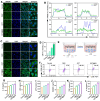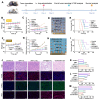A " CPApoptosis " nano-actuator switches immune-off solid tumors to immune-on for fueling T-cell- based immunotherapy
- PMID: 40213664
- PMCID: PMC11980655
- DOI: 10.7150/thno.105867
A " CPApoptosis " nano-actuator switches immune-off solid tumors to immune-on for fueling T-cell- based immunotherapy
Abstract
Background: Most anticancer agents induce tumor apoptosis, but they often lack immunogenicity and display limited success when combined with mainstream immunotherapies, thus killing cancer cells through multiple cell death modalities as well as switching immune-off tumors to immune-on is a strategy with great promise. To this end, we developed a CPApoptosis (cuproptosis, pyroptosis, apoptosis) nano-actuator for immunologically cold solid tumors. Methods: In this study, elesclomol (ES), a mitochondrial targeting copper transporter, was encapsulated within bacterial outer membrane vesicles (OMVs). These OMVs were then surface-modified via metal-phenolic self-assembly using Cu2+ and tannic acid (TA). Results: The Cu2+ and ES were released from the OMVs in a pH-dependent manner. OMV activated the non-canonical pyroptotic pathway, leading to cell membrane rupture. Cu2+ on the one hand was transported to the mitochondria for cuproptosis facilitated by ES, on the other hand, Cu2+ was reduced into Cu+ by TA, which catalyzed ROS production to induce oxidative apoptosis. Simultaneously, TA degraded glutathione (GSH), sensitizing cells to cuproptosis. The multifactorial cell death mechanisms led to the release of immunogenic factors from lysed tumor cells, stimulating dendritic cell maturation and recruiting cytotoxic T cells. This immune response was further amplified by αPD-L1 antibody treatment. Conclusion: The CPApoptosis nano-actuator represents a promising approach to enhance current cancer therapies, inducing both tumor cell death and a robust immune response, with the potential for long-lasting protective effects.
Keywords: apoptosis; bacterial outer membrane vesicle; cuproptosis; immunogenic cell death; pyroptosis.
© The author(s).
Conflict of interest statement
Competing Interests: The authors have declared that no competing interest exists.
Figures








Similar articles
-
Biomimetic Copper Nanozyme Reprograms Cold Tumor via Cuproptosis-Pyroptosis Crosstalk for Potent Renal Carcinoma Immunotherapy.ACS Appl Mater Interfaces. 2025 May 21;17(20):29291-29304. doi: 10.1021/acsami.5c03559. Epub 2025 May 8. ACS Appl Mater Interfaces. 2025. PMID: 40338096
-
Self-assembled copper chlorogenic acid nanoparticles: Inducing pyroptosis and cuproptosis to activate antitumor immunity.J Control Release. 2025 Aug 10;384:113941. doi: 10.1016/j.jconrel.2025.113941. Epub 2025 Jun 9. J Control Release. 2025. PMID: 40499764
-
Copper(II)-Based Nano-Regulator Correlates Cuproptosis Burst and Sequential Immunogenic Cell Death for Synergistic Cancer Immunotherapy.Biomater Res. 2024 Jun 27;28:0039. doi: 10.34133/bmr.0039. eCollection 2024. Biomater Res. 2024. PMID: 38938647 Free PMC article.
-
A Self-Amplifying ROS-Responsive Nanoplatform for Simultaneous Cuproptosis and Cancer Immunotherapy.Adv Sci (Weinh). 2024 Jun;11(23):e2401047. doi: 10.1002/advs.202401047. Epub 2024 Apr 3. Adv Sci (Weinh). 2024. PMID: 38569217 Free PMC article.
-
An up-To-Date Review of Elesclomol and Its Nano-Formulations in Cancer Therapy.Cancer Rep (Hoboken). 2025 Apr;8(4):e70193. doi: 10.1002/cnr2.70193. Cancer Rep (Hoboken). 2025. PMID: 40195280 Free PMC article. Review.
Cited by
-
Mechanism and application of copper-based nanomedicines in activating tumor immunity through oxidative stress modulation.Front Pharmacol. 2025 Jul 11;16:1646890. doi: 10.3389/fphar.2025.1646890. eCollection 2025. Front Pharmacol. 2025. PMID: 40717985 Free PMC article. Review.
-
Cuproptosis: A Review on Mechanisms, Role in Solid and Hematological Tumors, and Association with Viral Infections.Mediterr J Hematol Infect Dis. 2025 Jul 1;17(1):e2025052. doi: 10.4084/MJHID.2025.052. eCollection 2025. Mediterr J Hematol Infect Dis. 2025. PMID: 40636277 Free PMC article. Review.
References
-
- Meier P, Legrand AJ, Adam D, Silke J. Immunogenic cell death in cancer: targeting necroptosis to induce antitumour immunity. Nat Rev Cancer. 2024;24:299–315. - PubMed
-
- Kroemer G, Galassi C, Zitvogel L, Galluzzi L. Immunogenic cell stress and death. Nat Immunol. 2022;23:487–500. - PubMed
-
- Wang Q, Ju X, Wang J, Fan Y, Ren M, Zhang H. Immunogenic cell death in anticancer chemotherapy and its impact on clinical studies. Cancer Lett. 2018;438:17–23. - PubMed
MeSH terms
Substances
LinkOut - more resources
Full Text Sources
Medical

